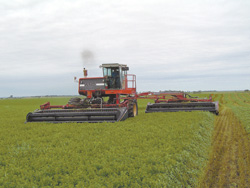
By Bill Gergen, Senior Editor
Dan Crick needed a hay windrowing machine with a lot of capacity. So the Menno, S. Dak., custom hay grower converted an old Massey 850 combine into what he calls an "articulated double windrower."
"It'll cut 32 ft. of hay at a time, or up to 20 acres per hour," says Crick.
The power unit rides on only two wheels and is designed to operate a pair of MacDon 16-ft. hydro-swing swathers -- one up front and one pulled behind and off to one side. To make the power unit he cut the combine off behind the engine compartment and removed the rear wheels, leaving only the cab, engine, drive train and front drive wheels. The front mower serves as the rig's front axle and is permanently mounted to the combine. The hydraulic pumps on each mower are driven by the combine's variable speed cylinder drive.
The machine articulates at the point where the front mower's hydroswing tongue connects to an extended tongue on front of the combine. The cylinder on the hydroswing tongue steers the machine. The oscillation point Crick fashioned between the two tongues allows the rig to ride comfortably on uneven ground.
"I built it three years ago and have used it to cut about 2,000 acres of hay each year. There's been a lot of local interest, and I've helped two other farmers build similar units," says Crick.
"Last summer I ran the machine in a July 4th parade. As a gag, I removed the back mower and replaced it with a big square baler to make it look like a cutting and baling machine. All day long people would come up to me and ask, can you really mow hay and bale it at the same time? I told them, yes, but that I have to drive very slowly to allow the freshly-cut hay to dry before it enters the baler."
Previously, Crick built a hydrostatic drive tractor out of an International 815 combine (Vol. 25, No. 5). He used it to pull a single hydroswing windrower. The tractor had a wide wheelbase, allowing it to straddle any size windrow.
"That machine worked good, but I wanted to work even faster to reduce hay drying time."
According to Crick, the only rig on the market that will cut hay with comparable volume is the New Holland bi-directional tractor, which is designed to push one mower and pull another. "However, that machine is short on horsepower and you have to lay a narrow windrow because it has to fit under the tractor's wheels. My machine has more power and can make windrows up to 8 ft. wide. And, I built it for a lot less money. I bought the combine used from a neighbor and was able to sell about parts off it. My main expense was for a second mower which I bought new. My total cost was minimal not counting the windrower I bought. And, the combine is fuel efficient. I'm averaging 1/4 gal. fuel per acre."
According to Crick, the entire rig isn't much longer than a tractor pulling a hydroswing mower behind it. "It'll turn around in a tight circle like you can't believe. When it turns, the front mower head will swing right inside the combine's drive wheel."
The combine has a variable speed hydrostatic transmission so Crick can speed up or slow down the engine to vary the pto speed on each mower. "The front mower is permanently mounted to the combine. But if the combine ever breaks down I can unhook the rear mower and pull it behind a tractor. If I wanted to I could use a hoist to take the existing front mower off and replace it with a new one."
Crick says he thought the machine would steer funny because the front mower's hydraulic cylinder is tied into the combine's steering system. But, it steers good. "It drives way better than a conventional combine, even at highway speeds," he says.
